Signs of the smallest mammals are more frequently seen than the animal itself unless you happen to see one scurry across the road. Mice, voles, lemmings and shrews are some of the smallest mammals in Idaho.
While they all seem to be small, furry critters, there are significant differences between mice, voles, lemmings and shrews. One major difference is that shrews are insectivores while mice, voles and lemmings are rodents–two different orders in the classification system.
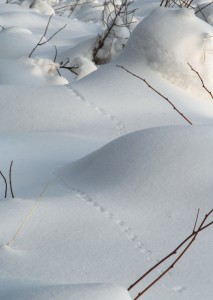
The trails of mice, voles, lemmings and shrews are often seen more in winter than the animals themselves
Mice exhibit a slender build with prominent ears, large eyes and well-developed whiskers. Voles and lemmings are relatively thick-bodied with small ears, snub nose, short tail and beady eyes. Shrews resemble mice but have pointed noses, small ears and tiny eyes.
Mice, voles and lemmings are rodents along with beavers, porcupines, squirrels, chipmunks and rats. All rodents share the characteristic of a prominent pair of incisors in the front of both the upper and lower jaws which supports their mainly herbivorous diet.
There are two native species of mice in North Idaho: the American deer mouse and the western jumping mouse. The house mouse is an introduced species also found in Idaho and throughout the United States.
The American deer mouse is a small- to medium-sized mouse that is nocturnal and active year-round. They range in color from dark-brown to orange-brown on their back with paler sides and a white belly. Their tail is equal to or slightly shorter than their body length (averaging 3.5 inches).
Deer mice occupy almost every habitat because they eat a variety of food– seeds, fruit, insects and subterranean fungi– and store extra in caches. The woodland form of the American deer mouse capitalizes on food found in trees since it can climb well.
Deer mice nest in hollow logs, underground burrows, birds’ nests, mattresses and among rocks.
House mice share many characteristics with deer mice but the house mouse’s tail is less hairy and its coat more gray. House mice tend to have a pale or gray belly unlike the white belly of deer mice.
House mice are also nocturnal and can climb well. They are most well-known for eating human food, soap, grain in agricultural areas and other items in buildings. House mice are less likely to be found in the woods and instead are found in agricultural areas, roadsides and in buildings in rural and urban areas.
Another small rodent found in North Idaho is the western jumping mouse and is different enough from the other mice to be classified in its own family. Jumping mice have the same contrasting belly as the American deer mouse but its tail has a small tuft of fur at the tip.
Jumping mice have extremely long, narrow tails and exceptionally long, hind feet that allow them to leap six to ten feet in a single bound when alarmed. They are less likely to be seen since they are mainly nocturnal and hibernate.
The jumping mouse hibernates for eight to ten months of the year. In the fall, jumping mice eat enough grass seeds, fruit, fungi and insects to accumulate a layer of fat for the winter. However, only about one-third of jumping mice survive hibernation.
The best place to catch a glimpse of western jumping mice is along streams through mountain meadows.
North Idaho’s three species of mice live in a variety of habitats but shouldn’t be mistaken for voles and lemmings, which I’ll cover in next week’s column.

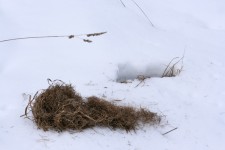
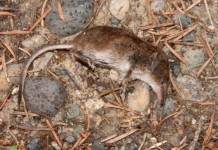
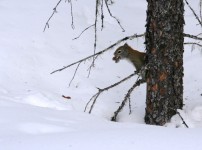
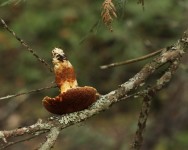
I am so happy to have discovered your web page. I lived east of Orofino, and then in Latah County for 35 years, and only recently returned to California. I have a great admiration for deer mice, after discovering that a small creature invading my Grangemont kitchen had demolished my native seed collection, while ignoring refined grains. They are so pretty, also. It’s a shame that we humans have to be careful about Hanta virus and other mouse-vectored diseases. I’ve also become fond of watching rabbits, compensating for the frustration of the 1950s and 60s, when populations exploded because we were destroying hawks and coyotes.